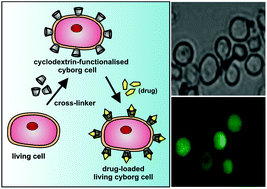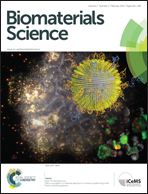Fabrication of viable cyborg cells with cyclodextrin functionality
Abstract
We describe two alternative methods for surface functionalisation of Saccharomyces cerevisiae cells with cyclodextrin molecules without affecting the cell viability. The first strategy involved using epichlorohydrin as a cross-linking agent which binds covalently the cyclodextrin to the glycoproteins on the cell wall. The second strategy of interfacing of the cells with CD involved polyelectrolyte mediated deposition of cyclodextrin sulphate on the cell surface. We used the formation of host–guest inclusion complexes of a dye with the grafted cyclodextrins to estimate the average number of CD molecules grafted per cell which can reach up to hundreds of millions of CD molecules. This indicates more than one monolayer of CDs on the cell surface within the surface layer surrounding the yeast cell membrane. Fluorescein diacetate was used to check the viability of the cells after functionalisation. Living cells functionalised with CDs may find many potential applications as they can be loaded with drugs, immunosuppressants and other molecules forming inclusion complexes with their cyclodextrin interface. Therefore, we foresee such cells being used as novel selective biosorbents in polluted waters, whole cell biosensors, drug delivery, cell therapy and cell implant applications.


 Please wait while we load your content...
Please wait while we load your content...